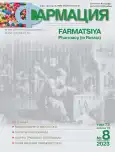Validation assessment of the method for the quantitative determination of phenolcarboxylic acids in the herb Phacelia tanacetifolia Benth
- Authors: Sheykhmagomedova P.A.1, Likhota T.T.1, Popova O.I.1
-
Affiliations:
- Pyatigorsk Medical and Pharmaceutical Institute – branch of Volgograd State Medical University
- Issue: Vol 72, No 8 (2023)
- Pages: 19-24
- Section: Pharmaceutical chemistry and pharmacognosy
- URL: https://journals.eco-vector.com/0367-3014/article/view/625590
- DOI: https://doi.org/10.29296/25419218-2023-08-03
- ID: 625590
Cite item
Abstract
Introduction. Increasing the number of medicinal plant materials used is possible with the help of those plants that are widely used in folk medicine, and also, no less interesting for study are previously unexplored plants of foreign flora. Тansy-leaf phacelia is widely cultivated in our country as a honey plant. Phacelia honey has found its use in folk medicine. The chemical composition of the studied object is characterized by a predominant content of phenolic compounds: phenol carbonic acids, flavonoids, tannins, and anthocyanins. Among phenolic compounds, as the main group of the chemical composition of the herb Phacelia tansy, phenolcarboxylic acids dominate in content. For medicinal plants used in folk medicine, standardization of medicinal plant raw materials is carried out according to the main group of compounds. To assess the quality of the herb Phacelia tansy, a method has been developed for quantitative determination of the amount of phenolcarboxylic acids, at which the maximum yield of biologically active substances was observed.
Purpose of the study. Conducting a validation assessment of the developed method for standardizing the herb Phacelia tansy.
Material and methods. The object of the study is the herbs of Phacelia tanacetifolia Benth., grown and collected on the territory of the Republic of Dagestan in the vicinity of the city of Kaspiysk during the flowering period in April 2022. The grass was dried by air-shadow method.
Results. Validation of the developed method was carried out according to the following indicators: specificity, linearity, accuracy and precision (repeatability). Based on the results obtained, it is clear that the validated method meets the appropriate acceptance criteria, which means it can be used to control the quality of the studied medicinal plant raw materials.
Conclusion. Thus, the proposed method for quantitative determination of the amount of phenolcarboxylic acids in the herb Phacelia tansy is suitable for standardization for this indicator.
Full Text
About the authors
Patimat Aigumovna Sheykhmagomedova
Pyatigorsk Medical and Pharmaceutical Institute – branch of Volgograd State Medical University
Author for correspondence.
Email: Patya16101998@yandex.ru
ORCID iD: 0009-0002-3251-5562
Graduate Student
Russian Federation, Kalinina Ave., 11, Pyatigorsk, 357532Tatiana Trofimovna Likhota
Pyatigorsk Medical and Pharmaceutical Institute – branch of Volgograd State Medical University
Email: lihotatt@yandex.ru
ORCID iD: 0009-0003-1082-8506
PhD, Associate Professor, Associate Professor of the Department of Pharmaceutical Chemistry
Russian Federation, Kalinina Ave., 11, Pyatigorsk, 357532Olga Ivanovna Popova
Pyatigorsk Medical and Pharmaceutical Institute – branch of Volgograd State Medical University
Email: beegeeslover@mail.ru
Doctor of Sciences (Pharmacy), Professor, Professor of the Department of Pharmacognosy, Botany and Phytopreparation Technology
Russian Federation, Kalinina Ave., 11, Pyatigorsk, 357532References
- Tokareva M.G., Prozhogina Yu.E., Kalenikova E.I., Dzhavakhyan M.A. Analysis of the assortment of the Russian market of medicinal herbal preparations with sedative effects. Issues of ensuring the quality of medicines. 2019; 2 (24): 4–19 (in Russian)
- Abrams L.R., Ferris R.S. Illustrated Flora of the Pacific States. Stanford, 1951; III: 493.
- Mysica A.A., Popov I.V. A popular honey plant is Phacelia tansy. Development, research and marketing of new pharmaceutical products: collection of scientific papers. Pyatigorsk, 2021; 187–92 (in Russian)
- Grossheim A.A. Flora of the Caucasus. M.-L., 1967; 7: 240 (in Russian)
- Sheikhmagomedova P.A., Popov I.V., Popova O.I. Morphological and anatomical study of the herb Phacelia tanacetifolia Benth. Bulletin of Voronezh State University. Series: Chemistry. Biology. Pharmacy. 2021; 2: 120–7 (in Russian)
- Chibis S.P., Smalyuga N.A., Chibis V.V. Sowing dates for the honey-bearing crop Phacelia tanacetifolia Benth. in the Omsk region. Diverse and sustainable development of agrobiocenoses of the Omsk Irtysh region: materials of the National scientific and practical conference dedicated to the 90th anniversary of the botanical garden of Omsk State Agrarian University. 2017; 169–74 (in Russian)
- Zeynep Dumanoğlu. General Characteristics and Importance of Phacelia (Phacelia tanacetifolia Bentham.) and Some Studies in Turkey. Turkish Journal of Agriculture – Food Science and Technology. 2019; 7 (2): 365–9. DOI: https://doi.org/10.24925/turjaf.v7i2.365-369.2349
- Andreeva V.Yu., Kalinkina G.I., Lee V.V. Development and validation of a method for the quantitative determination of the amount of phenolic acids in the aerial part of Ziziphora clinopodoides Lam. Chemistry of plant materials. 2019; 3: 161–8. doi: 10.14258/jcprm.2019034683. (in Russian)
- Sheikhmagomedova P.A. Experience in growing Phacelia tanacetifolia Benth. in the Republic of Dagestan. Belikov readings: materials of the IX International Scientific and Practical Conference. Pyatigorsk, 2021; 120–8 (in Russian)
- Sheikhmagomedova P.A., Popova O.I. Phytochemical study of Phacelia tanacetifolia. Materials of the 67th All-Russian Scientific Conference of Young Scientists and Students with International Participation. Makhachkala: IPC DSMU, 2019; 575–8 (in Russian)
- Sheikhmagomedova P.A. Determination of anthocyanins in flowers of Phacelia tanacetifolia Benth. Drug development – traditions and prospects: COLLECTION OF MATERIALS, Tomsk, September 13–16, 2021. Federal State Budgetary Educational Institution of Higher Education "Siberian State Medical University" of the Ministry of Health of the Russian Federation. – Tomsk: Siberian State Medical University Publishing House, 2021; 161–3 (in Russian)
- Sylwia Bajkacz, Irena Baranowska, Boguław Buszewski, Bartosz Kowalski, Magdalena Ligor. Determination of Flavonoids and Phenolic Acids in Plant Materials Using SLE-SPE-UHPLC-MS. MS Method Food Analytical Methods. 2018; 11: 3563–75.
- Martynov A.M., Chuparina E.V., Dargaeva T.D. Study of phenolic compounds and elemental composition of underground organs of Euphorbia fischeriana Steud. Chemistry of plant materials. 2022; 1: 269–76. doi: 10.14258/jcprm.2022019135. (in Russian)
- Lukashov R.I., Moiseev D.V., Stolyarova V.N., Makarenko M.N. Pharmacological activity of caffeic acid. Bulletin of Pharmacy. 2012; 3 (57): 61–5 (in Russian)
- Sheikhmagomedova P.A., Popova O.I. Identification of phenolic compounds and development of a method for quantitative determination of the amount of phenol carbonic acids in the herb Phacelia tanacetifolia Benth. Questions of biological, medical and pharmaceutical chemistry. 2022; 25 (12): 44–50. doi: 10.29296/25877313-2022-12-07 (in Russian)
Supplementary files






